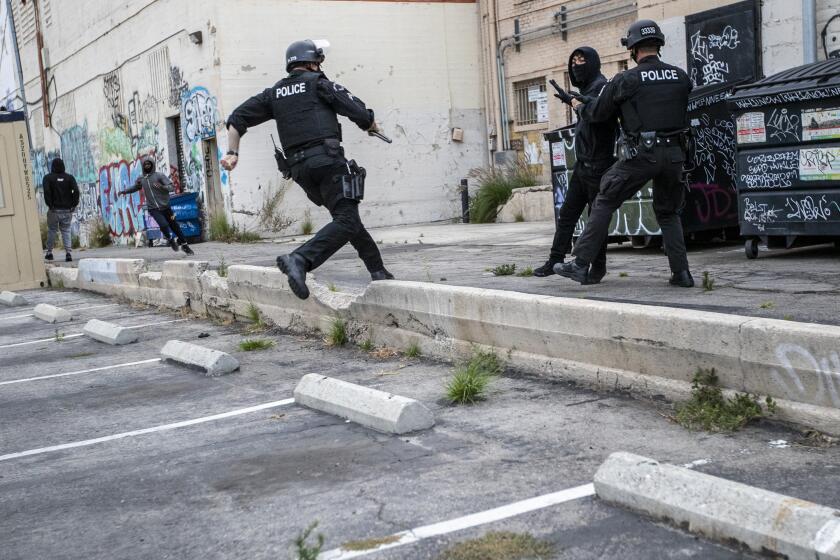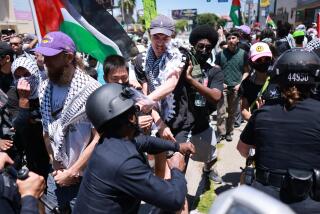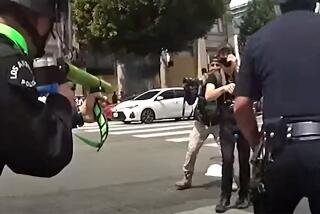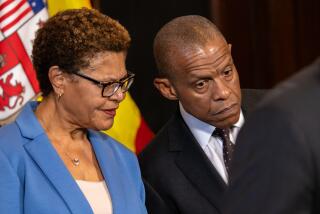Community organizer who trains police on bias injured by rubber bullet during protest
- Share via
Derrick Sanderlin volunteers with a group that trains San Jose Police recruits on how to root out bias and build ties with the community.
Officers’ actions at a protest against the death of George Floyd last week have him wondering whether the lessons have been ignored.
As Sanderlin stood between a line of protesters and police, pleading for the officers to stop shooting rubber bullets into the crowd, one of the officers appeared to take aim directly at his groin and fired.
The 27-year-old community organizer was seriously injured and has been told that he might no longer be able to have children.
“To see how the protest unfolded really, really disappointed me,” Sanderlin said Saturday. “Because I was holding the tension of already knowing what police relationships were like and also hoping for a change, hoping for something new and good. And it seems as if they [the officers] just didn’t get that message.”
San Jose police said they are investigating the incident and reevaluating how they use force to deal with crowds.
The May 29 protest was the first collective airing of grief to take place in San Jose in response to Floyd’s death under the knee of a Minneapolis police officer.
Hundreds of people marched through the streets. Sanderlin held a sign that read, “WE R WORTHY OF LIFE.”
“I had heard about the killing of George Floyd and many others from friends and from the news and it really devastated me,” Sanderlin said. “And I needed a place to sort of express that pain and that anger in a constructive way.”
The protesters spilled onto the 101 Freeway, blocking traffic. Their aim was to hold the vehicles on the freeway for about 8 minutes and 46 seconds, the same amount of time Officer Derek Chauvin’s knee was pressed into Floyd’s neck, Sanderlin said.
At one point, a group of people surrounded a Ford Mustang that had a ‘Blue Lives Matter’ license plate holder. Demonstrators exchanged words with the driver, and someone smashed the car’s back windshield.
Sanderlin stepped between the car and the crowd to mediate. Video of the protest that aired on ABC7 shows him shooing people away from the vehicle and leaning into the window to speak with the driver.
“As soon as I heard the glass break, I turned around and was like woah, woah, woah,” Sanderlin said. “He seemed like a nice dude. I just said, ‘get out of here, man!’ He seemed really upset and I didn’t want things to escalate further or anyone else to get hurt, so I just tried to encourage him to just move along.”
Sanderlin was able to diffuse the incident.
Recent protests in Los Angeles have served up a steady stream of troubling videos of police aggression and violence.
But as the protesters left the freeway to make their way to City Hall, something shifted in the police response to the demonstration, he said.
“On the way back, it just started to escalate as far as the cops intervening,” Sanderlin said. “They started shooting people point blank with riot guns [using rubber bullets]. Some of them were children, old women, folks who were not in any way acting violently against them.”
He said that as the police use of force intensified, five or six people in the back of the crowd of protesters began throwing bottles and trash at officers. Still, the vast majority of the protesters remained peaceful, he said.
By then, police had pushed the crowd back to City Hall. They were on 5th Street, in front of a church.
“I just turned around for a second and saw a really young woman, probably in her teens, being shot directly in the chest,” by rubber bullets, Sanderlin said. Officers were shooting the woman from a distance of about eight to 10 feet away, Sanderlin said.
“I couldn’t stand by and watch anymore,” he said.
Sanderlin walked sideways toward the line of police, his hands raised, and asked them to stop. Video footage shows him standing in front of the officers, his arms above his head.
“They told me to move and I said, ‘I can’t do that, please don’t do this,’” he said.
Some of the officers began to back off, he said.
“But a police officer behind them also with a riot gun pointed it directly at me and said ‘move,’” Sanderlin said. “And I sort of shook my head no and held onto my sign across my chest. And I was just really hoping he wasn’t going to shoot me.”
That’s when the officer, who was standing no more than 10 feet away, opened fire, Sanderlin said.
“And after he fired the riot gun, I realized he wasn’t aiming for my chest, and it hit me directly in the groin,” he said.
Sanderlin collapsed. He looked up and saw the officer discard the spent metal cylinder on the ground in front of him, he said.
At first, he didn’t realize the magnitude of the injury and tried to sleep it off. But two days later, he visited the hospital and learned he needed emergency surgery to repair a ruptured testicle.
Though the surgery was successful, doctors told him the trauma could make it impossible for him to have children. They said he won’t know for sure until he tries.
Sanderlin had to relay the news to his wife, who was waiting in the parking lot due to visitor restrictions made necessary by the coronavirus pandemic. He recently got a job processing COVID-19 cash relief applications for a nonprofit, and the couple had been hoping to save money and turn their attention toward starting a family within the next few years.
“I think it’s as difficult as anyone can imagine,” Sanderlin said quietly.
The community organizer also volunteers with a team that provides procedural justice and implicit bias training to classes at the San Jose Police Department Academy.
One of the major lessons is an idea called the community bank of trust.
“As soon as you put on a uniform, you are opening up an account at the community bank of trust, and that comes with a lot of complicated history, history nationally but also locally,” Sanderlin said, noting that when people have negative experiences with one police officer, it affects their view of others, as well.
“And so in the community bank of trust, you can either make deposits or withdrawals of that trust,” he said.
It was that teaching that came to Sanderlin’s mind, he said, as he saw the actions of the police officers at last week’s protest.
“As they started grabbing people and beating on them, putting their knees on people’s necks and stuff. Shooting people point blank. Pushing people. I just wondered where all of that went,” he said. “... I wondered where all of that talk about the community bank of trust was going.”
Sanderlin has retained an attorney, Sarah Marinho, who is preparing a federal civil rights lawsuit against the city and police department alleging excessive force. Marinho said she also brought the incident to the attention of the independent police auditor’s office, on whose community advisory board Sanderlin sits.
San Jose Police Chief Eddie Garcia has also reached out to Sanderlin to say he was “broken up” about his injury and would look into it, Sanderlin said.
“Derrick has been a real leader in our communities’ efforts to reduce bias and discrimination through dialogue,” Garcia said in a statement. “I assured him we will be investigating this incident.”
He said that the police department “has already begun to evaluate how we deal with crowd control situations,” including how they deploy projectiles like rubber bullets during confrontations.
That comes after San Jose Mayor Sam Liccardo on Friday introduced a proposal asking the police department to provide a report on how it decides when to use crowd control methods including projectiles and tear gas, and whether the department recommends banning the use of such projectiles.
“What happened to Derrick Sanderlin was wrong,” Liccardo tweeted Saturday.
Sanderlin said he hopes the city also considers reforms like divesting in funding for the police department and expanding the role of the independent police auditor’s office.
He said his ultimate hope is for “proper justice for families who have already been through much worse than myself.”
“I’m hoping that my story can open up a window for those folks to be seen and to be heard,” he said. “And that the city chooses to care for them and listen to them.”
More to Read
Sign up for Essential California
The most important California stories and recommendations in your inbox every morning.
You may occasionally receive promotional content from the Los Angeles Times.















